|
80x5 -
240x3 -
240x4 -
320x1 -
320x2 -
320x3 -
640x1 -
640x2
Set display option above.
Click on
images to enlarge. |
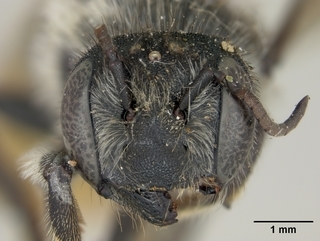
Smithsonian Institution, Entomology Department · 9
Megachile relativa, female, face |
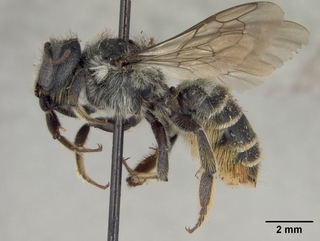
Smithsonian Institution, Entomology Department · 9
Megachile relativa, female, side |
|
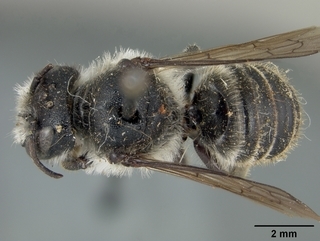
Smithsonian Institution, Entomology Department · 9
Megachile relativa, female, top |
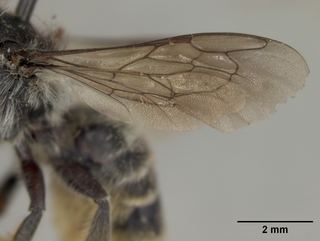
Smithsonian Institution, Entomology Department · 9
Megachile relativa, female, wing |
|
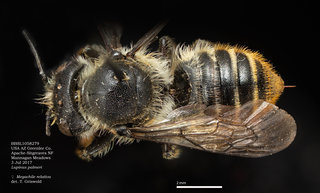
David Cappaert · 8
Megachile relativa, female, dorsal, BBSL |
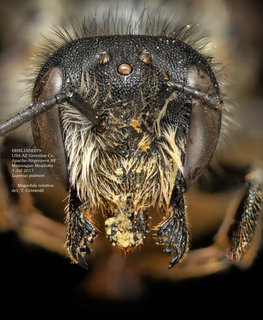
David Cappaert · 8
Megachile relativa, female, head, BBSL |
|
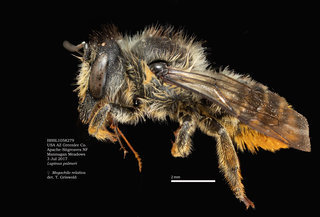
David Cappaert · 8
Megachile relativa, female, lateral, BBSL |
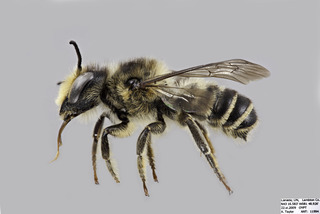
© Copyright Laurence Packer 2014
· 7
Megachile relativa MALE comp |
|
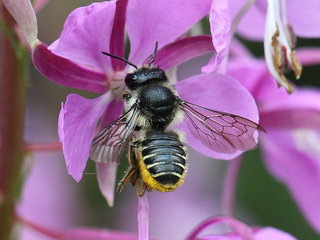
Michael Veit · 6
Megachile relativa f on Epilobi -- |
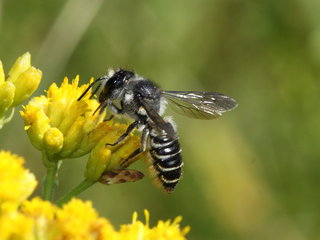
Michael Veit · 6
Megachile relativa, f on Solidag -- |
|
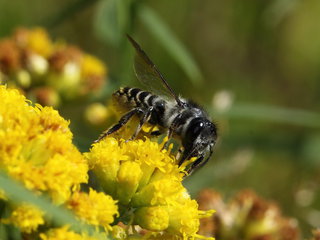
Michael Veit · 6
Megachile relativa, f on Solidag -- |
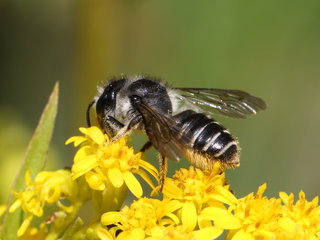
© Copyright Micheal Veit 2010
· 6
Megachile relativa, f on Solidag -- |
|
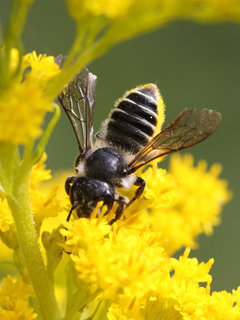
© Copyright Micheal Veit 2010
· 6
Megachile relativa, f on Solidag -- |
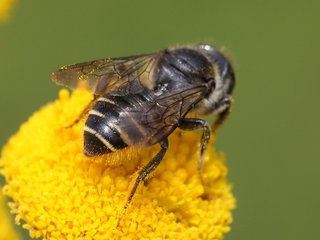
© Copyright Micheal Veit 2010
· 6
Megachile relativa, f on Tansy -- |
|
Overview |
Reprinted with permission from: Mitchell, T.B. 1962 Bees of the Eastern United States. North Carolina Agricultural Experiment Station Technical Bulletin No. 152.
FEMALE: Length 9-12 mm.; entirely black, including tegulae and legs, spurs yellow; eyes very slightly convergent below; clypeal margin nearly straight, obscurely crenulate; mandibles 5-dentate (fig. 40); lateral ocelli much nearer margin of vertex than to eyes; cheeks very slightly broader than eyes; punctures on vertex rather fine and shallow, to some degree separated, but rather irregular, becoming slightly more coarse and close on cheeks, face below ocelli more rugose, supraclypeal area rugose laterally but with a shining space medially, clypeus with rather shallow but quite close punctures; pubescence whitish, more or less erect and copious around antennae, lower half of face, and on cheeks; whitish and rather copious on thorax laterally and posteriorly, the vertex, scutum and scutellum with erect but rather thin and sparse, black pubescence; scutum shining medially where the punctures are well separated, quite shallow and rather coarse, becoming densely crowded laterally and anteriorly, those on scutellum and axillae somewhat finer and very close except in mid-line of scutellum; pleura somewhat shining below, punctures shallow and rather coarse, slightly separated, becoming closely crowded above where the surface is dull; propodeum smooth and somewhat shining; mid and hind basitarsi slightly shorter and narrower than tibiae; tegulae very finely and obscurely punctate anteriorly, otherwise smooth and impunctate; wings subhyaline, veins piceous; terga 2-4 with shallow, sub-basal grooves, their basal margins faintly carinate, apical margins of terga depressed laterally but not medially, these lateral areas quite densely whitish fasciate, discal pubescence erect and blackish, more copious, elongate and entirely white on basal tergum; punctures of basal tergum fine, well separated but not sparse, somewhat coarser on the more apical terga, apical margin of 5 depressed and whitish fasciate across entire width, 6 straight in profile, with a few, robust, erect, but rather short hairs evident, surface rather densely covered with yellowish, appressed tomentum; sternum 6 sparsely covered with scopal hairs and with an apical fringe of very short yellow hairs; scopa otherwise yellow, the sterna closely, deeply and rather finely punctate basally, punctures becoming somewhat more sparse on the more apical plates, apical margin of each sternum very narrowly yellowish-hyaline, not fasciate.
MALE: Length 8-10 mm.; entirely black, tegulae becoming testaceous along margins, legs somewhat reddened; eyes slightly convergent below; clypeal margin nearly straight, with a distinct and rather robust median tubercle; mandible 3-dentate, with a rather narrow, sub-basal, inferior process which is subtruncate apically; apical segment of flagellum slender and elongate; lateral ocelli considerably nearer margin of vertex than to eyes; cheeks somewhat broader than eyes; punctures rather fine, slightly separated across vertex posteriorly, rather sparse between ocelli and eyes, becoming more regularly close on cheeks above, densely crowded or rugose below; face below ocelli rather coarsely rugosopunctate, becoming finely so below antennae and over clypeus; pubescence whitish, quite long and copious around antennae and lower part of face, on cheeks below and on thorax laterally and posteriorly; vertex, scutum and scutellum with more or less intermixed light and dark hairs which are quite long and erect but rather thin; scutum rather dull, punctures close, rather shallow, not very coarse, slightly separated only in center of disc; punctures of scutellum slightly separated along mid-line, but otherwise quite uniformly close, those on axillae much finer and densely crowded; pleura rather dull, punctures shallow, quite close and rather vague; propodeum relatively smooth and shining; basitarsi quite short and slender, the more apical tarsal segments to some degree yellowish; mid tibial spurs short but well developed; tegulae shining, rather uniformly, minutely and rather closely punctate; wings subhyaline, veins piceous; terga 2-4 shallowly grooved or depressed across base, basal margin of grooves not distinctly carinate, apical margins of terga depressed only toward sides, depressed medially only on 4 and 5, pale apical fasciae evident at extreme sides of the more basal terga, more or less complete on 4 and 5, discal pubescence rather thin and short, largely pale, but with dark hairs evident toward sides on all except basal tergum which is covered with quite copious, elongate, whitish pubescence; punctures very fine, surface shining, rather close on tergum 2 barely evident on 1, quite sparse on 3 and 4, becoming somewhat coarser laterally, but still well separated, 5 with somewhat closer and coarser punctures throughout; tergum 6 shining, carina very low, broadly and shallowly in- curved medially, punctures fine and close above carina, becoming somewhat more coarse and sparse laterally, median teeth of apical margin broadly carinate, widely separated, relatively near the short, acute, lateral teeth; tergum 7 quite prominent, broad and short, with a deep excavation on dorsal surface; sterna 1-4 exposed, closely but rather vaguely punctate, apical margins of 2-4 broadly yellowish-hyaline and with thin, apical fringes of pale hairs; setose area of sternum 5 restricted, finely setose (fig. 41) ; sternum 6 sparsely setose on each side, apical lobe inevident; gonocoxites slender, protuberant basally, apex acute (fig. 42).
DISTRIBUTION: Mackenzie to Newfoundland, south to California, Illinois, Tennessee and Georgia, May to October in the more southern parts of its range.
FLOWER RECORDS: Aster, Baptisia, Brassica, Chrysanthemum, Epilobium, Geranium, Houstonia, Melilotus, Physallis, Ranunculus, Rhodora, Rosa, Ru bus, Rudbeckia, Solidago, Trifolium and Zizia.
|
|
|
Identification | |
Extracted from: Sheffield C. S., et al (2011). Leaf cutter and Mason Bees of the Genus Megachile Latreille (Hymenoptera; Megachilidae) in Canada and Alaska. Canadian Journal of Arthropod Identification No. 18 Megachile (Megachile) relativa Cresson, 1878 Megachile (Megachile) relativa Cresson, 1878. Trans. Amer. Entomol. Soc. 7: 126 (♀). Megachile (Xanthosarus) exclamans Viereck, 1916. Bull. Conn. State Geol. Nat. Hist. Survey 22: 743 (♀). Megachile aspera Mitchell, 1924. Jour. Elisha Mitchell Sci. Soc. 40: 158 (♀).
Diagnosis: The female of M. relativa can be recognized by the combination of 5-dentate mandibles, entirely pale scopa, and T6 with erect, golden pubescence. They are most similar to M. centuncularis and M. lapponica. The female of M. centuncularis has T6 with pubescence entirely black. The female of M. lapponica has black scopal hairs on S6. The male can be recognized by the combination of simple and dark front tarsi, front coxa without spine, 3-dentate mandibles with the teeth equally spaced, clypeus with a prominent median tubercle on apical margin, the inner and outer tarsal claws that are equally sharp, the first submarginal cell with vein r subequal to vein Rs of the second submarginal cell, and a less prominent hypostomal tubercle and a more shallow, less defined hypostomal concavity. They are most similar to M. centuncularis, M. inermis and M. lapponica. Males of M. centuncularis lack a median tubercle on the clypeus, and have the outer tarsal claw much more rounded than the inner claw. Males of M. inermis have 3-dentate mandibles with the 2nd tooth much closer to the apical tooth than the inner tooth. Males of M. lapponica have the first submarginal cell with vein r shorter than vein Rs of the second submarginal cell, more prominent hypostomal tubercle and a deep, well defined hypostomal concavity. Males of M. relativa can only be distinguished with certainty from M. lapponica by examining the genitalia (see Discussion under M. lapponica). FEMALE: Length 9-12 mm.
Head. 1) compound eyes slightly convergent below; lateral ocelli nearer margin of vertex than eyes (5:6), 2) clypeal margin nearly straight, obscurely crenulate and slightly emarginated medially, 3) mandibles 5-dentate, with an incomplete cutting edge between 2nd and 3rd teeth (Plate 1, Figure M18), 4) gena slightly broader than compound eye (7:6), 5) punctures on vertex rather fine and shallow, to some degree separated, but rather irregular, becoming slightly more coarse and close on gena, frons more rugosopunctate, supraclypeal area rugose laterally but with shining interspaces medially, clypeus with rather shallow but quite close punctures, 6) pubescence whitish, more or less erect and copious around antennae and on gena though hardly obscuring surface; clypeus with intermixture of pale and darker hairs, vertex and area surrounding ocelli with erect, rather sparse, black pubescence, 7) F1 longer than broad (2:1), twice as long as pedicel, and longer than remaining flagellomeres, which are slightly longer than broad (2:1.7), apical flagellomere more elongate, about twice as long as broad. Mesosoma. 1) pubescence whitish and rather copious on mesosoma laterally and posteriorly and on upper segments of legs, becoming yellow on apical segments, the mesoscutum and scutellum with erect, rather sparse, black pubescence, 2) mesoscutum shining medially, the punctures quite shallow and rather coarse, with distinct interspaces, becoming densely crowded laterally and anteriorly, those on scutellum and axilla somewhat finer and very close, slightly separated on scutellum medially; pleura somewhat shining below, punctures shallow and rather coarse, slightly separated, becoming closely crowded above where the surface is dull; propodeum smooth and somewhat shining, punctures vague and fine, triangle shiny and impunctate, 3) mid and hind basitarsi slightly shorter and narrower than their tibiae, spurs yellow, 4) tegula very finely and obscurely punctate anteriorly, with shallow and sparse punctures in posterior half, 5) wings subhyaline, veins black. Metasoma. 1) T2-T4 with shallow, subbasal grooves, their basal margins faintly carinate, apical margins of terga depressed laterally but not medially, quite densely whitish fasciate laterally, discal pubescence erect and black, more copious, elongate and entirely white on T1; punctures of T1 fine, well separated but not sparse, somewhat coarser and irregular on the more apical terga, T5 with a shallow, subbasal groove laterally, with basal margin of groove faintly carinate, apical margin of T5 depressed and whitish fasciate across entire width, T6 straight in profile, with a few, robust, erect, but rather short hairs, surface rather densely covered with yellowish, appressed tomentum, 2) S6 sparsely covered with scopal hairs and with an apical fringe of very short yellow hairs; scopa otherwise yellow; the sterna closely, deeply and rather finely punctate basally, punctures becoming somewhat more sparse on the plates apically, apical margin of each sternum very narrowly yellowish-hyaline. MALE: Length 8-10 mm. Head. 1) compound eyes slightly convergent below; lateral ocelli slightly nearer to eye than margin of vertex (6:5), 2) clypeal margin nearly straight, with a distinct and rather robust median tubercle, 3) mandible 3-dentate, lower process rather narrow, subtruncate apically, subbasal in position, 4) gena somewhat broader than compound eye (8:7), 5) punctures rather fine, slightly separated across vertex posteriorly, rather sparse between ocelli and eyes, becoming more regularly close on gena above, densely crowded or rugosopunctate below; frons and supraclypeal area rather coarsely rugosopunctate, becoming finely so below antennae and over clypeus, hypostomal tubercle short, hypostomal concavity shallow and not well defined, 6) pubescence whitish, quite long and copious around antennae and lower part of face and on gena below; vertex with more or less intermixed light and dark hairs that are quite long and erect but rather sparse, black hairs present along inner margin of eyes and around ocelli, 7) F1 longer than broad (3:2), twice as long as pedicel, slightly shorter than to subequal in length to remaining flagellomeres, which are longer than broad, apical flagellomere more elongate, twice as long as broad. Mesosoma. 1) pubescence whitish, quite long and copious laterally and posteriorly; mesoscutum and scutellum with more or less intermixed light and dark hairs that are quite long and erect but rather sparse, 2) mesoscutum rather dull, punctures close, rather shallow, not very coarse, slightly separated only in center of disc; punctures of scutellum slightly separated along mid-line, but otherwise quite uniformly close, those on axilla much finer and densely crowded; pleura rather dull, punctures shallow, quite close and rather vague; propodeum relatively smooth and shining, punctures fine and well spaced medially, triangle shiny and impunctate, 3) basitarsi quite short and slender, the more apical tarsomeres to some degree yellowish; mid tibial spur short but well developed, 4) tegula shining, rather uniformly, minutely and rather closely punctate in anterior half, punctures becoming sparse posteriorly, 5) wings subhyaline, veins black, vein r of first submarginal cell normally subequal to vein Rs of second submarginal cell. Metasoma. 1) T2-T4 shallowly grooved or depressed across base, basal margin of grooves not distinctly carinate, apical margins of terga depressed only toward sides, depressed medially only on T4 and T5, pale apical fasciae evident at extreme sides of the more basal terga, more or less complete on T4 and T5, discal pubescence rather sparse and short, largely pale, but with dark hairs evident toward sides on all except T1, which is covered with quite copious, elongate, whitish pubescence; punctures very fine, surface shining, rather close on T2 barely evident on T1, quite sparse on T3 and T4, becoming somewhat coarser laterally, but still well separated, T5 with somewhat closer and coarser punctures throughout; T6 shining, carina very low, broadly and shallowly incurved medially, punctures fine and close above carina, becoming somewhat more coarse and sparse laterally, median teeth of apical margin broadly carinate, widely separated, relatively near to the short, acute, lateral teeth; T7 quite prominent, broad and short, with a deep excavation on dorsal surface, 2) S1-S4 visible, closely but rather vaguely punctate, apical margins of S2-S4 broadly yellowish-hyaline and with thin, apical fringes of pale hairs, which is interrupted medially on S4. Genitalia. Plate 2, Figure G18. Discussion. Megachile relativa is one of the the most common members of the genus in Canada; it is commonly collected in trap-nests (Table 1), and is often found nesting in commercial nests of M. rotundata (pers. obs.). The cold-hardiness of this species was previously studied by Krunic and Salt (1971). Distribution. Widespread throughout Canada from NS-BC, and into the western subarctic (see Map 18).
Extracted from: Robertson, C. (1897). North American Bees - Description and Synonyms. Transactions of the Academy of Science od St. Louis. Vol. 7. No. 14.
The ♂ has the anterior coxae unarmed.
|
|
|
Names | |
|
|
| Supported by | |
Updated: 2024-07-27 01:56:23 gmt
|